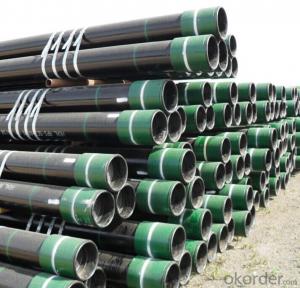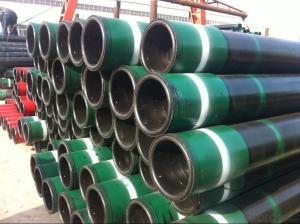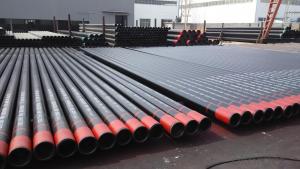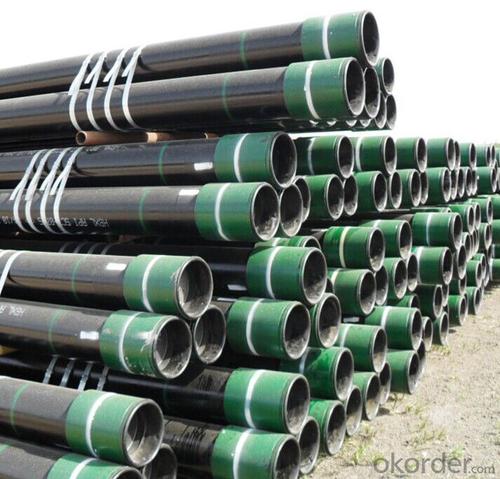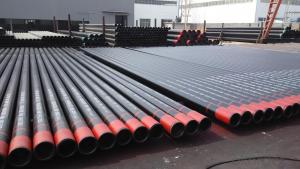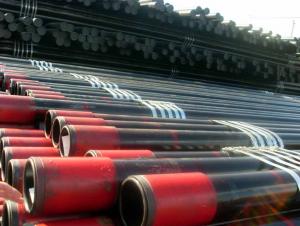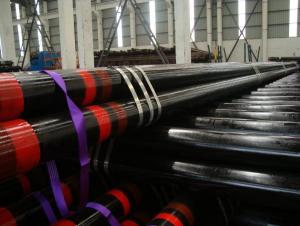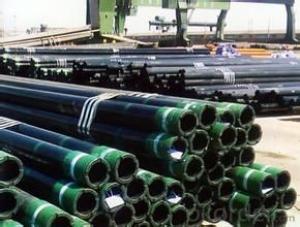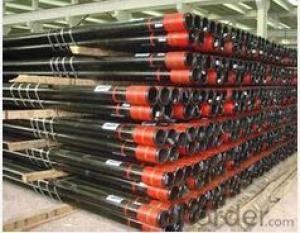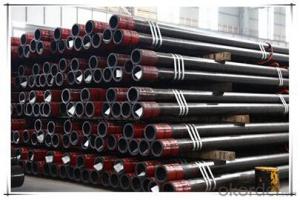API Standard Oil and Gas Well Casing Tube 5B14
- Loading Port:
- Tianjin
- Payment Terms:
- TT OR LC
- Min Order Qty:
- 1000 m.t.
- Supply Capability:
- 20000 m.t./month
OKorder Service Pledge
OKorder Financial Service
You Might Also Like
Specification
Integral-joint tubing upsetting at one end, external threading, and external upsetting at the other end, internal threading. API integral-joint tubing is on the market in OD dimensions of 1.315 to a couple of.063 inch.
API integral-joint tubing provides 10-round form together with a joint strength which is less than the body minimum yield, this reduces its use.
The small OD of integral-joint tubing enables its use inside of larger tubing strings or inside of wells as unloading or vent strings.
The couplings will need to meet all the minimum specifications outlined in API Spec. 5CT. API Spec. 5B3 and API RP 5B14 cover threading, gauging, and thread inspection.
Specifications
| Parameters | Value | |
|---|---|---|
| Material | J55, K55, N80, N80Q, L80, P110, other grade available as your requirement | |
| Outer Diameter | 2-3/8"~4-1/2" (73.02~114.3mm) | |
| Wall Thickness | 4.83~16mm | |
| Forms of Thread | EUE, NUE and Integral-joint | |
| Length Range | R1(20~24ft), R2(28~32ft) | |
| MTR | accordance with API Specification 5CT |
Tolerances
| Parameters | Value | |
|---|---|---|
| Outside diameter | +-0.031 inch (0.79mm) | |
| Wall thickness | -12.5%, positive deviations are limited by pipe weight | |
| Weight Deviation | +6.5% /-3.5% |
Mechanical Properties
| Grade | Tensile Strength (PSI/MPa) | Yield Strenght (PSI/MPa) | ||
|---|---|---|---|---|
| H-40 | No less than 60000(414) | Between 40000 (276) ~ 80000 (552) | ||
| J-55 | No less than 75000 (517) | Between 55000 (379) ~ 80000 (552) | ||
| N-80 | No less than 100000 (689) | Between 80000 (552) ~ 110000 (758) | ||
| P-110 | No less than 125000 (862) | Between 110000 (758) ~ 140000 (965) |
Inspection
Physical properties are checked and each length hydrostatically tested, normally to only 3,000 psi in the plain end (unthreaded) condition. The following are also checked:
Dimensions
Weights
Straightness
Lengths
Part of this inspection is to drift all lengths.
Despite all the American Petroleum Institute (API) specifications and testing, some tubing defects are still found after delivery; thus, some operators do further inspection.
Inspection Method
Size and surface inspection
NDT and pressure test and third party certication
Hydrostatic
Drifting test
Physical and chemicail analysis
Hardness and pressure test.
Electromagnetic
Magnetic particle
Ultrasonic
Dimensions and Weight
| sizes | OD D mm | weight | wt t mm | Type of end | |||||||||||
| 1 | 2 | NU kg/m | EU kg/m | IJ kg/m | |||||||||||
| NU | EU | IJ | |||||||||||||
| H40 | J55 | L80 | N80 1/Q | C90 | T95 | P110 | |||||||||
| 1 | 2 | 3 | 4 | 5 | 6 | 7 | 8 | 9 | 10 | 11 | 12 | 13 | 14 | 15 | 16 |
| 2-3/82-3/8 2-3/8 2-3/8 2-3/8 | 4.004.60 5.80 6.60 7.35 | -4.70 5.95 - 7.45 | – - - - | 60.3260.32 60.32 60.32 60.32 | 5.956.85 8.63 9.82 10.94 | -6.99 8.85 - 11.09 | – - - - | 4.244.83 6.45 7.49 8.53 | PUPNU - - - | PNPNU - - - | PNPNU PNU P PU | PNPNU PNU - - | PNPNU PNU P PU | PNPNU PNU P PU | -PNU PNU - - |
| 2-7/82-7/8 2-7/8 2-7/8 2-7/8 2-7/8 | 6.407.80 8.60 9.35 10.50 11.50 | 6.507.90 8.70 9.45 - - | – - - - - | 73.0273.02 73.02 73.02 73.02 73.02 | 9.5211.61 12.80 13.91 15.63 17.11 | 9.6711.76 12.95 14.06 - - | – - - - - | 5.517.01 7.82 8.64 9.96 11.18 | PNU- - - - - | PNU- - - - - | PNUPNU PNU PU P P | PNUPNU PNU - - - | PNUPNU PNU PU P P | PNUPNU PNU PU P P | PNUPNU PNU - - - |
| 3-1/23-1/2 3-1/2 3-1/2 3-1/2 3-1/2 3-1/2 | 7.709.20 10.20 12.70 14.30 15.50 17.00 | -9.30 - 12.95 - - - | – - - - - - | 88.9088.90 88.90 88.90 88.90 88.90 88.90 | 11.4613.69 15.18 18.90 21.28 23.07 25.30 | -13.84 - 19.27 - - - | – - - - - - | 5.496.45 7.34 9.52 10.92 12.09 13.46 | PNPNU PN - - - - | PNPNU PN - - - - | PNPNU PN PNU P P P | PNPNU PN PNU - - - | PNPNU PN PNU P P P | PNPNU PN PNU P P P | -PNU - PNU - - - |
| 44 4 4 4 4 | 9.5010.70 13.20 16.10 18.90 22.20 | -11.00 - - - - | – - - - - | 101.60101.60 101.60 101.60 101.60 101.60 | 14.14- 19.64 23.96 28.13 33.04 | -16.37 - - - - | – - - - - | 5.746.65 8.38 10.54 12.70 15.49 | PNPU - - - - | PNPU - - - - | PNPU P P P P | PNPU - - - - | PNPU P P P P | PNPU P P P P | – - - - - |
| 4-1/24-1/2 | 12.6015.20 | 12.75- | – | 114.30114.30 | 18.7522.62 | 18.97- | – | 6.888.56 | PNU- | PNU- | PNUP | PNU- | PNUP | PNUP | – |
| 4-1/24-1/2 4-1/2 4-1/2 4-1/2 | 17.0018.90 21.50 23.70 26.10 | – - - - | – - - - | 114.30114.30 114.30 114.30 114.30 | 25.3028.13 32.00 35.27 38.84 | – - - - | – - - - | 9.6510.92 12.70 14.22 16.00 | – - - - | – - - - | PP P P P | – - - - | PP P P P | PP P P P | – - - - |
| P——Plain end;N—Non-upset threaded and coupled;U—External upset threaded and coupled;I—insert joint. | |||||||||||||||
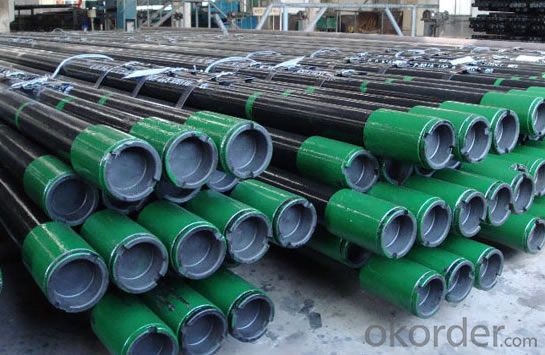
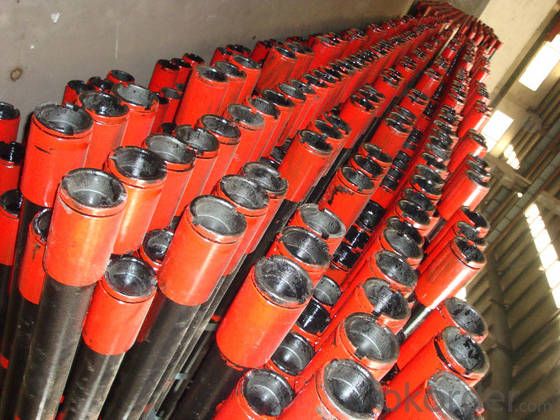


- Q: When can I use the PVC pipe and when to use the galvanized pipe?
- PVC pipeline use temperature is -5 to 90 degrees or so, according to the current market price of around 6000 yuan per ton, the price is cheap. Its corrosion resistance is good, can resist most of the acid and alkali, and unlike the steel pipe that is easy to rust, so in the construction of the upper and lower water pipes and other fields have gradually replaced the trend of steel pipe.
- Q: How are steel pipes coated for protection against external elements?
- Steel pipes can be coated for protection against external elements through a process called corrosion protection coating. This typically involves applying a layer of protective coating, such as epoxy or polyethylene, onto the surface of the steel pipes. The coating acts as a barrier, preventing moisture, chemicals, and other external elements from coming into direct contact with the steel, thus reducing the risk of corrosion and extending the lifespan of the pipes.
- Q: What is the average lead time for manufacturing steel pipes?
- The average lead time for manufacturing steel pipes can vary depending on several factors such as the complexity of the design, size of the order, and the specific production capabilities of the manufacturer. Typically, it can range from a few weeks to a few months.
- Q: What is the fatigue strength of steel pipes?
- The fatigue strength of steel pipes refers to their ability to withstand repeated cyclic loading without experiencing failure. It is a critical characteristic for pipes that are subject to dynamic or fluctuating loads, such as those used in the oil and gas industry, transportation infrastructure, or industrial applications. The fatigue strength of steel pipes can vary depending on several factors, including the steel grade, pipe dimensions, manufacturing process, surface conditions, and environmental factors. Steel pipes with higher tensile strength and toughness generally exhibit better fatigue resistance. The fatigue strength is typically determined through fatigue testing, which involves subjecting the pipes to cyclic loading until failure occurs. The results are then used to establish a fatigue curve or S-N curve, which represents the relationship between the applied stress amplitude and the number of cycles to failure. The fatigue strength is commonly expressed as the stress amplitude required to cause failure after a specific number of cycles, such as the stress amplitude at 10 million cycles (S-N10^7). It is important to note that fatigue strength is influenced by other factors, such as mean stress, surface finish, and loading frequency, which may need to be considered in specific applications. Overall, the fatigue strength of steel pipes is a crucial factor to consider in engineering design and maintenance, as it helps ensure the long-term integrity and reliability of the pipes under cyclic loading conditions.
- Q: How are steel pipes protected against seismic activities?
- Steel pipes are protected against seismic activities through various measures such as designing them to be flexible and resilient, using seismic joints and hangers, and implementing proper anchoring and support systems. Additionally, steel pipes are often coated with protective materials to enhance their resistance to corrosion and other external factors that may be triggered by seismic events.
- Q: Can steel pipes be used for underground oil and gas pipelines?
- Yes, steel pipes can be used for underground oil and gas pipelines. Steel is a widely used material in the oil and gas industry due to its strength, durability, and resistance to corrosion. Steel pipes are capable of withstanding the high pressure and extreme conditions often encountered in underground pipelines, making them a reliable choice for transporting oil and gas.
- Q: Can steel pipes be used for wastewater treatment plants?
- Yes, steel pipes can be used for wastewater treatment plants. Steel pipes are commonly used in these facilities due to their high strength, durability, and resistance to corrosion, making them suitable for handling the harsh and corrosive nature of wastewater. Additionally, steel pipes can be easily welded and are available in various sizes, making them versatile for different applications within wastewater treatment plants.
- Q: How are steel pipes used in the manufacturing of fire sprinkler systems?
- Steel pipes are commonly used in the manufacturing of fire sprinkler systems due to their durability and fire resistance properties. These pipes serve as a reliable conduit for water or fire suppression agents to flow through, ensuring that the sprinkler system effectively extinguishes fires. The high strength of steel pipes allows for the construction of a robust and long-lasting system that can withstand high pressure and heat, making them an ideal choice for fire safety installations.
- Q: How are steel pipes used in the shipbuilding industry?
- Steel pipes are commonly used in the shipbuilding industry for various applications such as the construction of the ship's hull, piping systems for fuel, water, and other fluids, as well as for the ventilation and drainage systems on board. These pipes provide strength, durability, and corrosion resistance, making them ideal for withstanding the harsh marine environment.
- Q: What is the difference between seamless and welded steel pipes?
- The main difference between seamless and welded steel pipes lies in their manufacturing process. Seamless pipes are made by piercing a solid cylindrical steel billet to create a hollow tube without any welding or joints. On the other hand, welded pipes are formed by rolling a flat steel plate and then welding the edges together to create a cylindrical shape. This welding process introduces a seam along the length of the pipe. Consequently, seamless pipes are typically considered stronger, more reliable, and better suited for high-pressure applications, while welded pipes are more cost-effective and commonly used for less demanding applications.
Send your message to us
API Standard Oil and Gas Well Casing Tube 5B14
- Loading Port:
- Tianjin
- Payment Terms:
- TT OR LC
- Min Order Qty:
- 1000 m.t.
- Supply Capability:
- 20000 m.t./month
OKorder Service Pledge
OKorder Financial Service
Similar products
Hot products
Hot Searches
Related keywords
